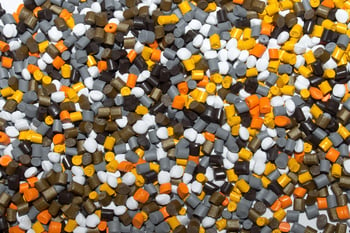 There are numerous applications where applying a specialized coating to a custom wire basket or rack can greatly improve the durability or utility of the basket. For example, in ultrasonic parts cleaning, adding a layer of soft, thick material that cushions impacts can keep parts from getting scratched by the basket during the ultrasonic cavitation process. Or, some coatings can provide extra resistance to specific chemicals, prolonging the wire form’s useful life.
There are numerous applications where applying a specialized coating to a custom wire basket or rack can greatly improve the durability or utility of the basket. For example, in ultrasonic parts cleaning, adding a layer of soft, thick material that cushions impacts can keep parts from getting scratched by the basket during the ultrasonic cavitation process. Or, some coatings can provide extra resistance to specific chemicals, prolonging the wire form’s useful life.
However, to get the most out of coatings for custom wire baskets & racks, it’s important to know the properties of each.
To help you know more about the various coating options for custom baskets, here is a bit of information about several popular coatings:
Polyethylene
Cited by the Encyclopaedia Britannica as “the most widely used plastic in the world,” polyethylene is a material that most people should be familiar with. This coating is available in a number of different formulations for specialized applications.
As a coating for a basket, polyethylene is often used to improve a basket’s resistance to acidic or basic compounds by keeping these chemicals from reaching the basket’s surface. Polyethylene has considerable resistance to both acids and bases at room temperature, so it’s ideal for this use.
Polyethylene coatings typically have a smooth, hard surface that is resistant to tearing.
However, due to a low melting temperature, polyethylene is generally not used in manufacturing applications where high temperatures are expected. Additionally, prolonged exposure to oxygen and light can weaken the material, so it’s also unsuited to outdoor applications.
Polypropylene
Polypropylene (also known as polypropene) is a thermoplastic polymer that boasts a strong resistance to acids, alkalis, and organic solvents alike. It is a low-weight, low-density material when compared to some other coatings.
This material is also noted for its resistance to fatigue stresses, which is why it is often used for joints in plastic containers that are meant to flex.
However, like polyethylene, a polypropylene coating has a relatively low melting point—roughly 340 degrees Fahrenheit—that makes it unsuited for high-temperature applications. Also, while resistant to non-oxidizing acids, polypropylene is susceptible to oxidizing acids, chlorinated hydrocarbons, and aromatics, and will quickly degrade when exposed to them.
Polyvinyl Chloride (PVC)
Of all the thermoplastic coatings offered by Marlin, PVC is perhaps the one that is most commonly applied to wire forms not being used in high-temperature applications. The material boasts an incredible level of resistance to chemical attack and can be applied in thick layers.
PVC is generally applied as a basket coating using one of two methods: dipping and fluid bed.
- Dipping processes involve submerging the wire form to be coated in a pool of liquid PVC and letting it cure. When applied this way, the PVC coating tends to be both very thick and soft—often used in ultrasonic parts cleaning to minimize parts scratching.
- Fluid bed processes use a powdered PVC solution to dip the basket in—or an ionized cloud of powder can be used as well. This method leaves a thinner coating of material.
In many aspects, PVC coatings compare favorably to polypropylene ones. However, they still have a low maximum use temperature threshold (around 140 degrees Fahrenheit), and are susceptible to ketones, chlorinated hydrocarbons, and aromatics.
Polyvinylidene Fluoride (PVDF)
PVDF is regarded as a relatively strong and abrasion-resistant fluorocarbon material that is useful at higher temperatures than most of the other coatings on this list. In fact, PVDF is able to resist distortion and retains most of its strength at temperatures up to 280 degrees Fahrenheit.
Also, a PVDF coating is highly resistant to acids, bases, and organic solvents—making it ideal in parts washing applications where these solutions are frequently used. The material is a low-weight, high-strength one that also boasts low permeability to keep chemicals from reaching the base material of the basket. And, unlike some other polymers, PVDF is resistant to ultraviolet radiation, so sunlight won’t cause it to degrade.
Which is Best for Your Basket?
The answer to this question depends on the nature of your process. In applications with operating temperatures in excess of 140°F, but not 280°F, PVDF might be the best option since the other coatings on this list cannot withstand those temperatures. For an ultrasonic parts washing application, the PVC coating may be best to protect parts from getting scratched.
To make a good recommendation about which coating to use for your custom wire basket or tray, Marlin’s engineering team would need to know some specifics about your process and goals. This is why the Marlin team sends customers a custom basket questionnaire.
With the information in the questionnaire, Marlin Steel can make the best recommendation for which coating material to use for your custom wire forms—or determine if a coating material is even necessary.
Need a coated wire basket for a specific application? Contact Marlin Steel today for a custom basket quote, or check out our steel coatings reference sheet at the link below!



.gif)


